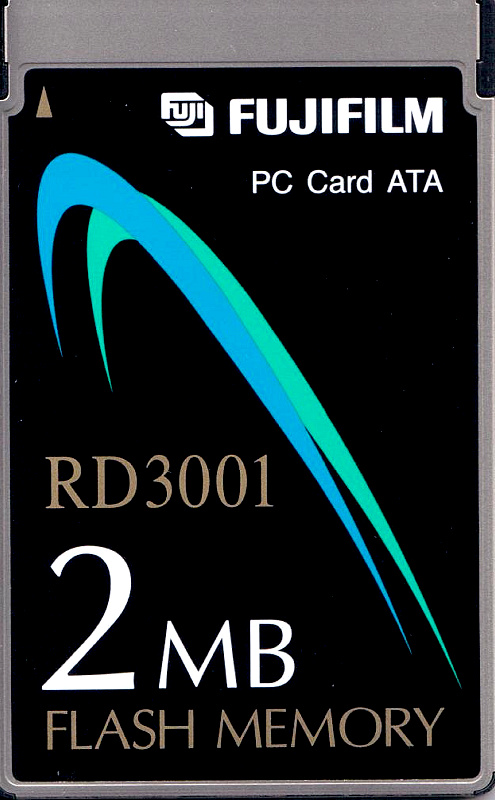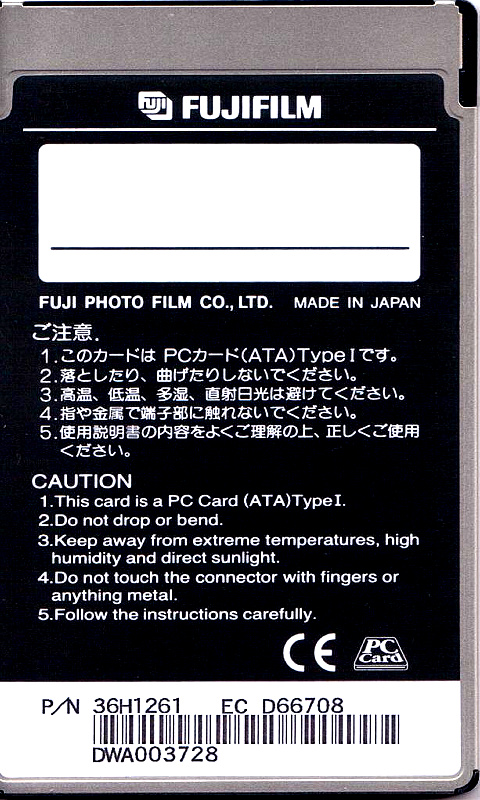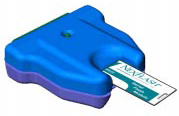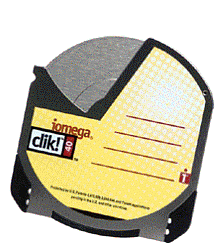(Flash) memory card types and other means of storage
Flash memory. Solid-state memory. There is and has been a variety of storage possibilities for still cameras. From the early Video Floppy Disks to the modern, high-capacity SDXC and Eye-Fi memory cards, both electronic still and digital cameras have always needed a means to store images. Internal or external memory, recorded images would have been lost without it. What used to be extremely expensive became so cheap that memory cards can be bought in convenience stores nowadays for a few bucks. The price sunk from a several hundred dollars per Megabyte to merely a few dollars per Gigabyte. Not to mention the variety of card readers and adapters that became available over the years. The first Video Floppy Disk players and SRAM card readers were very expensive and bulky. Today, people are actually working on such odd things as tiny smartmedia to SD card adapters. Go figure!
What most people seem to forget though is that a Smartmedia, SRAM and PC ATA Card is a versatile and multi-purpose storage medium. Certain sellers ask mind-boggling prices for such cards only because they think it was made for one specific machine (for instance industrial and medical appliances). Please, don't fall for that! Oh and by the way, the decline in prices of memory cards is very high. Best example are Compact Flash cards, the smaller ones are virtually worthless. But this does not apply to all memory cards. There are vintage memory cards that actually are very expensive nowadays because they became rare and sought after. For instance all 5V Smartmedia cards, especially the ones with a capacity larger than 2MB. Also, the very thin and battery operated SRAM cards are hard to get by and costly.
1969 - Digital Cassette
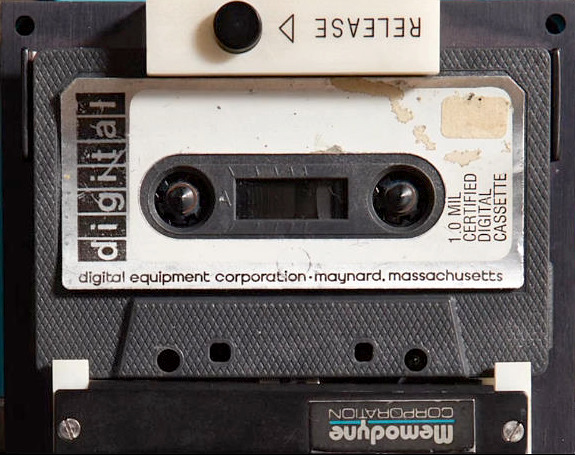
digital cassette Well... uuuh, a digital cassette? Of course! The earliest form of image data storage was on magnetic tape. Even before Sony unveiled their MaviPaks in 1981 there were digital cassettes. Not to be confused with the digital audio tape (DAT) or the digital compact cassette (DCC) though. The earliest record of a digital cassette I could find was a 1969 paper. Hence the date for this entry. I assume the digital cassette evolved directly from audio cassettes (invented by Philips in 1962) to a reliable digital memory. A lot of data storage was done with digital cassettes in the seventies. No wonder Steven Sasson used a Memodyne digital cassette recorder for his prototype. In the picture you can see such a typical seventies digital cassette. Ampex and Memodyne were the main manufacturers for digital cassette recorders back then.
Introduced by: ? in 1969?
Size:approx. 76x101mm
Medium: magnetic tape
Versions:unknown
Used by: Kodak Prototype a.o.
1981 - Video Floppy Disk

Video Floppy DiskVideo Disks were not only used by Electronic Still Cameras but also other video systems in medical and industrial fields. Even television stations used Video Disks to display still images when experiencing technical difficulties. Fuji later went on to produce a digital 1MB version of the Video Floppy Disk called LT-1. Intended for SVC it's only use was in a 1989 Zenith Minisport Laptop. Few know that apart from the Video Floppy Disks there were also cleaning disks available back then. These are almost impossible to find these days and basically a very important item for keeping Still Video Equipment in good, running shape. The cleaning disks had a small patch of velco inside. To reach the cleaning effect one had to apply two drops of cleaning alcohol on the velcro. A perfect overview of all the different VF disks can be found here: Crimsons Systems

 Introduced by: Sony in 1981
Introduced by: Sony in 1981
Size:approx. 50x50mm
Medium: analog magnetic disk
Versions:VF-50, HiVF and Mavipak
Used by: practically all Electronic Still Cameras from the 80's and early 90's
1981 - Sony 3.5" Floppy Disk

Sony 3.5" Floppy Disk 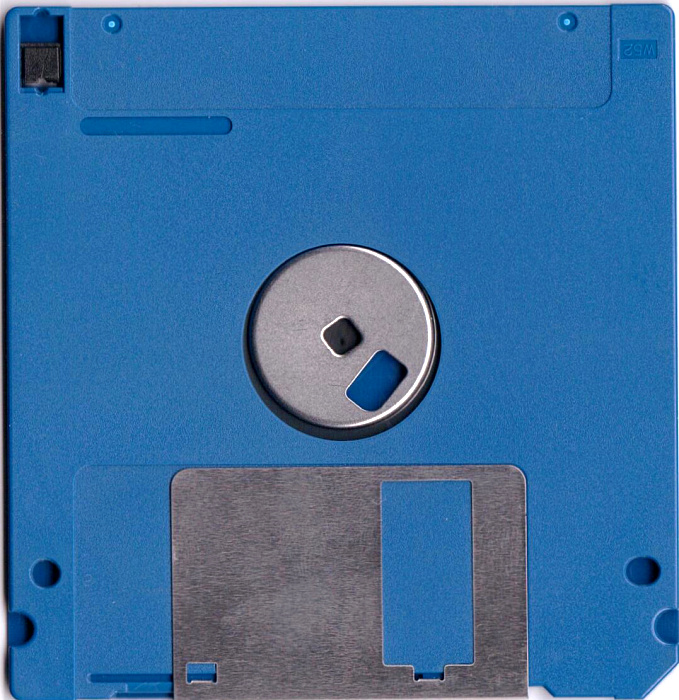 As a "company of firsts", Sony introduced the most popular Floppy Diskette of all time in 1981. It didn't find it's way into digital cameras until 1997, when Sony marketed the first digital Mavicas, the MVC-FD5 and MVC-FD7. Although it was a magnet disk, the images were stored digitally. Sony's digital Mavicas were the first digital cameras to be really mass-marketed. Because it used such an "ancient" storage medium, some people try to sell them off as rarities, which in fact, they are not. It's the most common digital camera from the 90's and the perfect starting point for vintage digital camera collectors. After 30 years, Sony stopped production of the Floppy Disk. Since Sony was dominating the market with diskette cameras, Panasonic came forth and introduced two cameras that also worked with Floppy Disks but they didn't sell well.
As a "company of firsts", Sony introduced the most popular Floppy Diskette of all time in 1981. It didn't find it's way into digital cameras until 1997, when Sony marketed the first digital Mavicas, the MVC-FD5 and MVC-FD7. Although it was a magnet disk, the images were stored digitally. Sony's digital Mavicas were the first digital cameras to be really mass-marketed. Because it used such an "ancient" storage medium, some people try to sell them off as rarities, which in fact, they are not. It's the most common digital camera from the 90's and the perfect starting point for vintage digital camera collectors. After 30 years, Sony stopped production of the Floppy Disk. Since Sony was dominating the market with diskette cameras, Panasonic came forth and introduced two cameras that also worked with Floppy Disks but they didn't sell well.
Introduced by: Sony in 1981
Size:approx. 90x94mm
Medium: analog magnetic disk
Versions:Single-sided, Double-sided and High-Density
Used by: All Sony Digital Mavica MVC-FDxx cameras and Panasonic PV-SD4090, PV-SD5000
1988 - SRAM Image Memory Card (IC Memory Card)
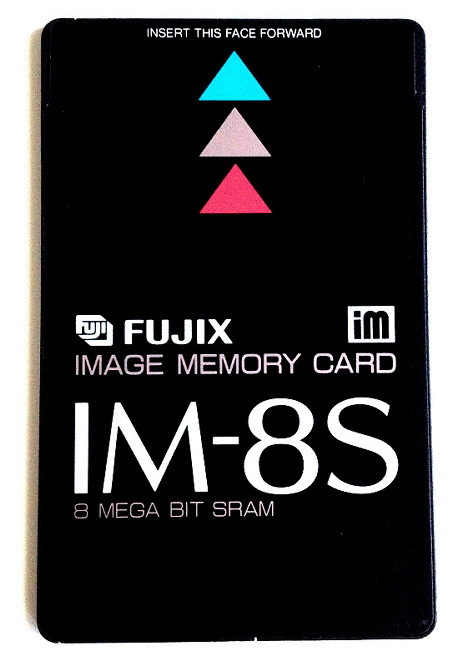
SRAM Card
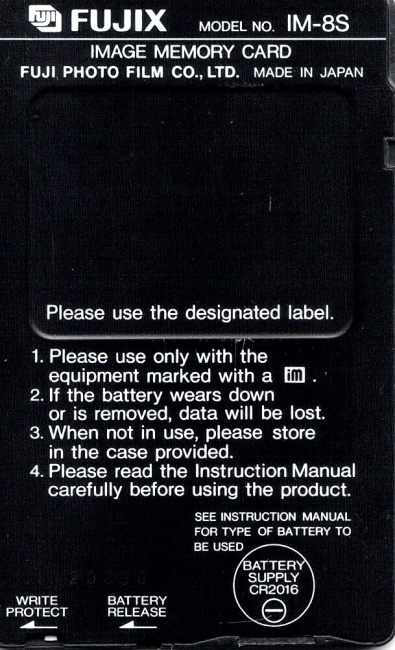 The SRAM cards was developed jointly by Fujifilm and Toshiba. It was equipped with a battery to store the images permanently in the IC's. If the battery was depleted all recorded images would be lost. SRAM cards with a rechargeable battery also existed.
The SRAM cards was developed jointly by Fujifilm and Toshiba. It was equipped with a battery to store the images permanently in the IC's. If the battery was depleted all recorded images would be lost. SRAM cards with a rechargeable battery also existed.
Introduced by: Fuji/Toshiba in 1988
Size:approx. 85x54mm
Medium: Flash Memory Card
Voltage:5 Volts
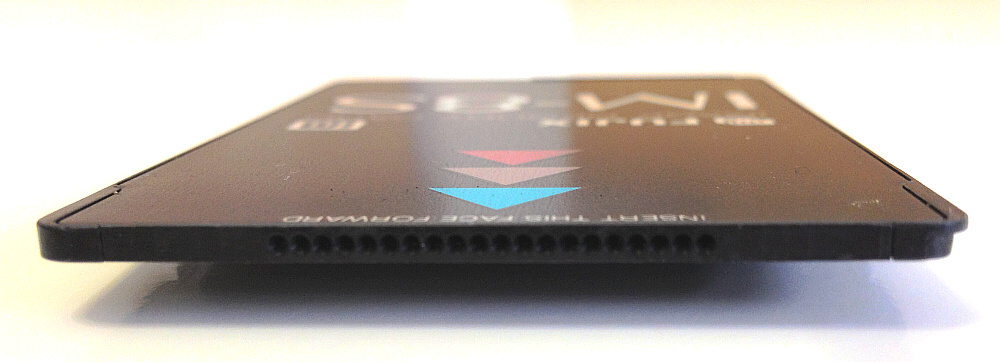 Battery:CR-2016
Battery:CR-2016
Pins:20
Used by: Fujix DS-1P, DS-X, DS-100, DS-200F, DS-H2 and Toshiba I(M)C-100
1991 - PCMCIA ATA Card Type I
The Personal Computer Memory Card International Association, formed in 1986, developed the PCMCIA card in 1990 to compete with the japanese JEIDA memory card. In 1991 they were merged into one standard. Initially conceived as a memory-expansion card, it was also used as a computer peripheral card and flash memory cards.
Introduced by: PCMCIA in 1991
Size:approx. 85x54mm
Medium: Flash Memory Card
Voltage:3.3/5 Volts
 Thickness:3.3mm
Thickness:3.3mm
Pins:68
Used by: Fujix DS220, Kodak DC50, Ricoh RDC2, Sony DKC-ID1
Olympus Deltis VC-1100, some Kodak DCS cameras a.o.
1992 - PCMCIA ATA Card Type II
Same card as the PC Card Type I but 5mm thick and now with 32bit interface support. Type-II cards introduced I/O support, allowing devices to attach an array of peripherals or to provide connectors but this didn't apply to flash memory cards.
Introduced by: PCMCIA in 1992
Size:approx. 85x54mm
Medium: Flash Memory Card
Voltage:3.3/5 Volts
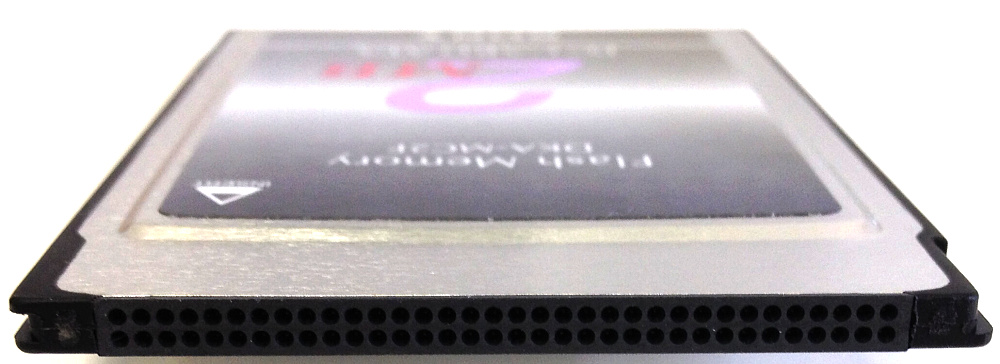 Thickness:5mm
Thickness:5mm
Pins:68
Used by: Fujix DS220, Kodak DC50, Ricoh RDC2, Sony DKC-ID1
Olympus Deltis VC-1100, some Kodak DCS cameras a.o.
1993 - PCMCIA ATA Card Type III
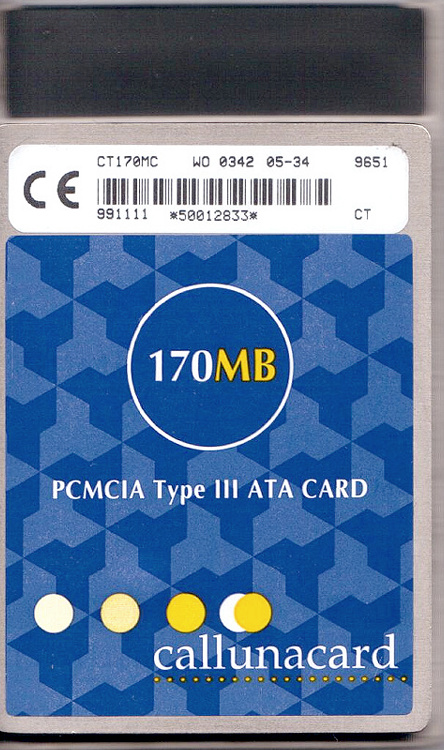
PC Card Type III  Same as the Type II but thicker and equipped with a 1.8-inch spinning platter. The connector side of all three types is identical with 3.3mm guide rails. The type III card allowed for higher storage capacity since it incorporated a tiny harddisk drive. The first DSLRs therefore used these cards.
Same as the Type II but thicker and equipped with a 1.8-inch spinning platter. The connector side of all three types is identical with 3.3mm guide rails. The type III card allowed for higher storage capacity since it incorporated a tiny harddisk drive. The first DSLRs therefore used these cards.
Introduced by: PCMCIA in 1993
Size:approx. 85x54mm
Medium: Magnetic coated platter
Voltage:3.3/5 Volts
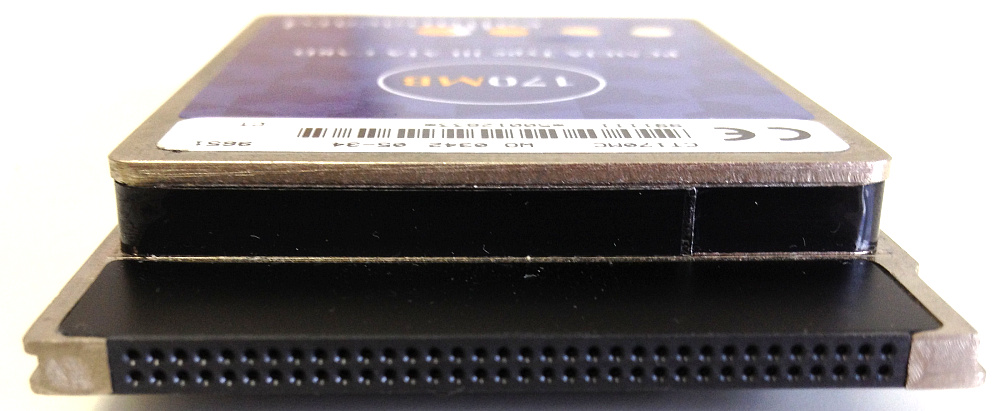 Thickness:10.5mm
Thickness:10.5mm
Pins:68
Used by: Rollei dFlex, Hitachi MP-EG1, AGFA ActionCam
Minolta RD-175, some Kodak DCS cameras a.o.
1993 - MiniDisc Data
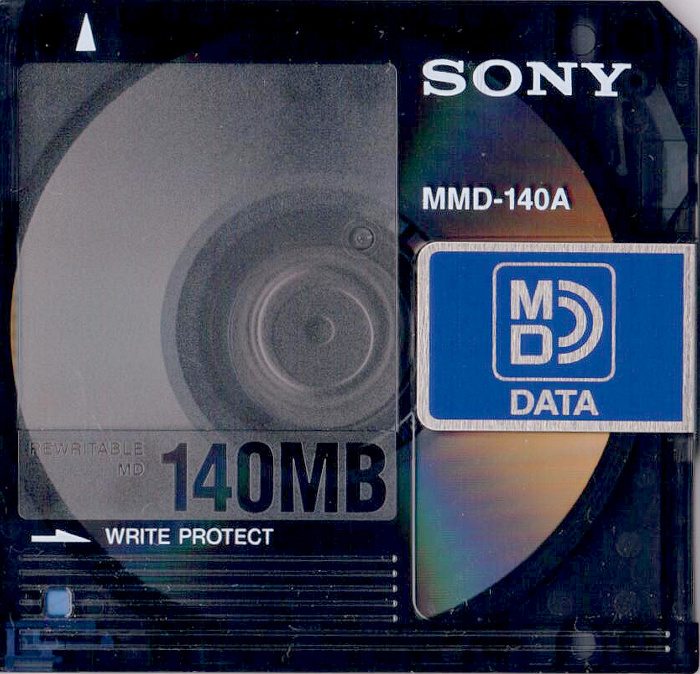
Sony MD Data 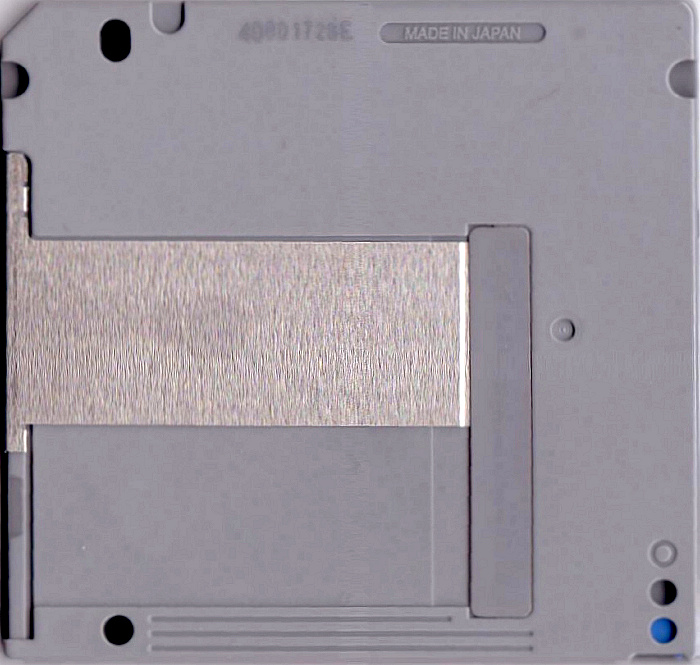 Sony introduced the MiniDisc in 1992 as a magneto-optical medium for storing digitized audio. The disc itself is housed in a cartridge and was intended to replace the analog audio cassette. In 1993 Sony brought to market the MD Data. This disc was capable of storing 140MB of computer data and was intended to replace the Floppy Diskette. Unfortunately it was not compatible with the audio minidisc and thus failed to sell. Iomega's Zip Drive finally filled that void and cheap CD-writers and CD-R's killed the MD Data.
Sony introduced the MiniDisc in 1992 as a magneto-optical medium for storing digitized audio. The disc itself is housed in a cartridge and was intended to replace the analog audio cassette. In 1993 Sony brought to market the MD Data. This disc was capable of storing 140MB of computer data and was intended to replace the Floppy Diskette. Unfortunately it was not compatible with the audio minidisc and thus failed to sell. Iomega's Zip Drive finally filled that void and cheap CD-writers and CD-R's killed the MD Data.
Introduced by: Sony in 1993
Size:approx. 72x68mm
Thickness:5mm
Medium: magneto-optical disk
Versions:140MB (MD Data) and 650MB (MD-Data2)
Used by: Sony DSC-MD1 and Sharp MD-PS1
1994 - Compact Flash Card Type I
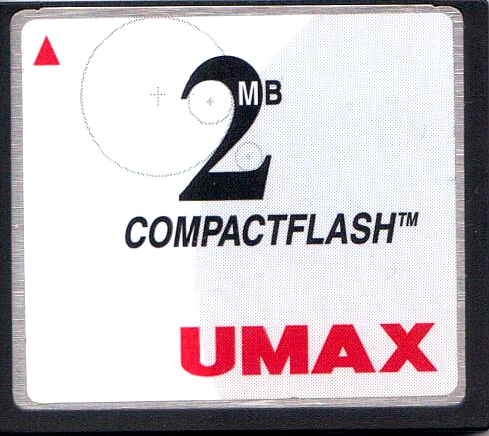
Compact Flash Card  The Compact Flash card is among the oldest and most successful memory storage cards. It is still in use today and is also a very popular card for PDA's and other equipment. The standard CF card is 3.3mm thick and the Microdrive card 5mm. Together with a PCMCIA adapter it could also easily be used in cameras with PC card slot.
The Compact Flash card is among the oldest and most successful memory storage cards. It is still in use today and is also a very popular card for PDA's and other equipment. The standard CF card is 3.3mm thick and the Microdrive card 5mm. Together with a PCMCIA adapter it could also easily be used in cameras with PC card slot.
Introduced by: SanDisk in 1994
Size:approx. 42x36mm
Medium: Flash Memory Card
Voltage:3.3/5 Volts
Thickness:3.3mm
Pins:50
Used by: Kodak DC25, later Epson PhotoPC models, HP Photosmarts
Most Panasonic cameras, some Casio QV cameras, a.o.
1995 - Miniature Card

Miniature Flash Card 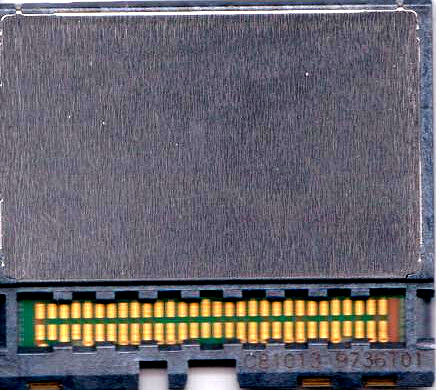 Intel introduced this card in 1995. The Miniature Card Implementers Forum (MCIF) promoted this card for consumer electronics like PDA's, smartphones and digital cameras. Fujitsu, AMD and Sharp backed it up. Intel shipped this card to OEM manufacturers in July of 1996. The card was to compete with Smart Media and Compact Flash but it didn't succeed. It is no longer manufactured. 16MB was the highest capacity available. Intel had big plans for this one, there was talk of an USB keyboard with Miniature Card slot, a PCMCIA card adapter and an USB reader/writer. At one point in 1997 both AMD and Intel offered evaluation kits which included a card reader/writer for the PC's internal ISA bus. The kit sold for around $299. I was pointed towards a completely alternative solution by our reader, Mr. Roman Kober, who told me that Olympus also used this card in their digital voice recorder model D1000. It turned out that Olympus had an extra PC kit for this in their portfolio containing a PCMCIA Miniature Card Adaptor! Great news as Olympus was the first manufacturer ever to utilize the Miniature Card in a device.
Intel introduced this card in 1995. The Miniature Card Implementers Forum (MCIF) promoted this card for consumer electronics like PDA's, smartphones and digital cameras. Fujitsu, AMD and Sharp backed it up. Intel shipped this card to OEM manufacturers in July of 1996. The card was to compete with Smart Media and Compact Flash but it didn't succeed. It is no longer manufactured. 16MB was the highest capacity available. Intel had big plans for this one, there was talk of an USB keyboard with Miniature Card slot, a PCMCIA card adapter and an USB reader/writer. At one point in 1997 both AMD and Intel offered evaluation kits which included a card reader/writer for the PC's internal ISA bus. The kit sold for around $299. I was pointed towards a completely alternative solution by our reader, Mr. Roman Kober, who told me that Olympus also used this card in their digital voice recorder model D1000. It turned out that Olympus had an extra PC kit for this in their portfolio containing a PCMCIA Miniature Card Adaptor! Great news as Olympus was the first manufacturer ever to utilize the Miniature Card in a device.
Introduced by: Intel in 1995
Size:approx. 38x33mm
Medium: Flash Memory Card
Voltage:3,3 and 5 Volts
Thickness:3mm
Pins:60
Used by: HP PhotoSmart, Intel PC Camera, Aztech MDC180
Samsung DigiMax 30/50 and Konica Q-EZ as well as the Olympus D1000 digital voice recorder
1995 - Smart Media Card

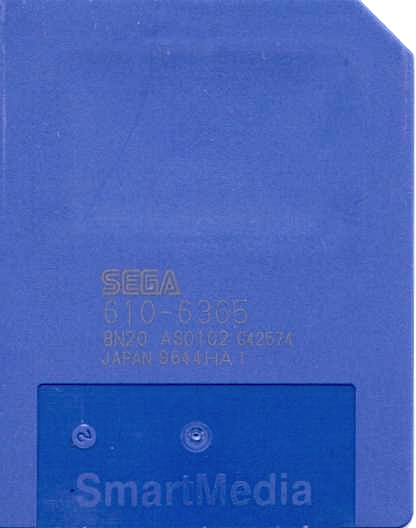 The Smart Media Card is by far the thinnest flash memory card to date. It is only 0.76mm thick. The SM Card was introduced to compete (guess what!) with all the above mentioned cards. It was originally called Solid State Floppy Disk Card (SSFDC) and was at first considered a Floppy Diskette successor. Therefore they can also be used in 3.5" disk drives by using a FlashPath Adapter. The SM card was not only a very popular card for digital cameras but also for Synthesizers and Keyboards (e.g. Roland). The SM card had it's peak at the turn of the century when about half the digital camera market used it. But the card's capability was limited to 128MB. Higher camera resolution and the need for higher storage capacity marked the end for SmartMedia cards. Now they are no longer produced but still very popular among vintage tech enthusiasts. Note that the 5V cards and 3,3V cards are not compatible with each other but some devices can handle both of them, like the Philips ESP-80 for instance.
The Smart Media Card is by far the thinnest flash memory card to date. It is only 0.76mm thick. The SM Card was introduced to compete (guess what!) with all the above mentioned cards. It was originally called Solid State Floppy Disk Card (SSFDC) and was at first considered a Floppy Diskette successor. Therefore they can also be used in 3.5" disk drives by using a FlashPath Adapter. The SM card was not only a very popular card for digital cameras but also for Synthesizers and Keyboards (e.g. Roland). The SM card had it's peak at the turn of the century when about half the digital camera market used it. But the card's capability was limited to 128MB. Higher camera resolution and the need for higher storage capacity marked the end for SmartMedia cards. Now they are no longer produced but still very popular among vintage tech enthusiasts. Note that the 5V cards and 3,3V cards are not compatible with each other but some devices can handle both of them, like the Philips ESP-80 for instance.
 Introduced by:Toshiba in 1995
Introduced by:Toshiba in 1995
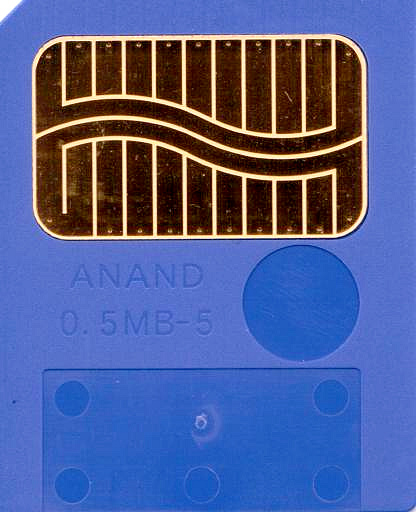 Size:approx. 1.7 by 1.4 inches
Size:approx. 1.7 by 1.4 inches
Medium Flash Memory Card
Voltage:3.3/5 Volts
Thickness:3.3mm (Type I) and 5mm (Type II)
Pins:50
Used by: The majority of Fuji and Olympus cameras. Toshiba, Philips and Agfa cameras a.o.
1995 - PhotoSpan Memory Module
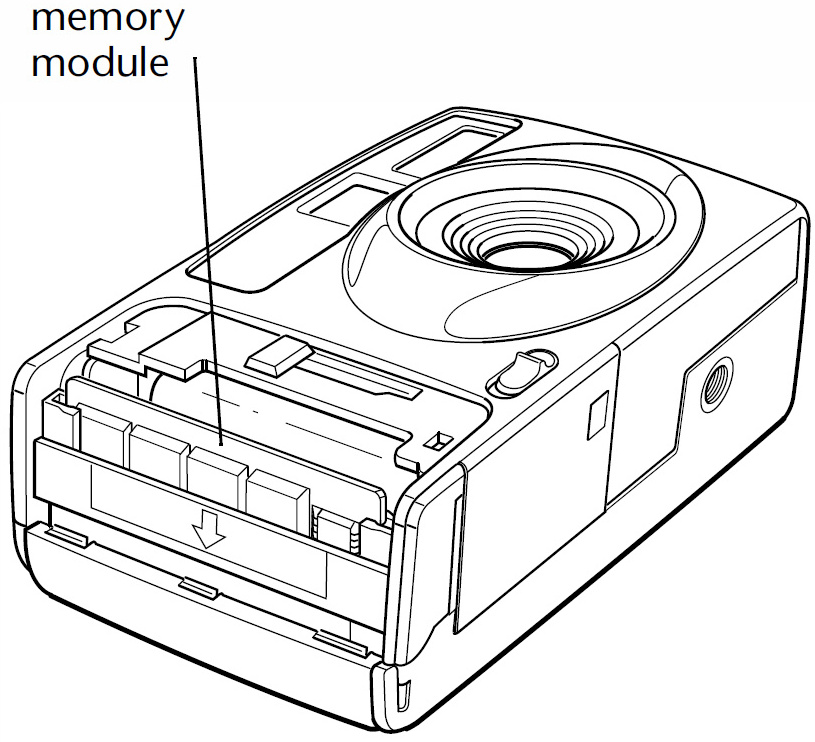
Epson PhotoPC manual drawing 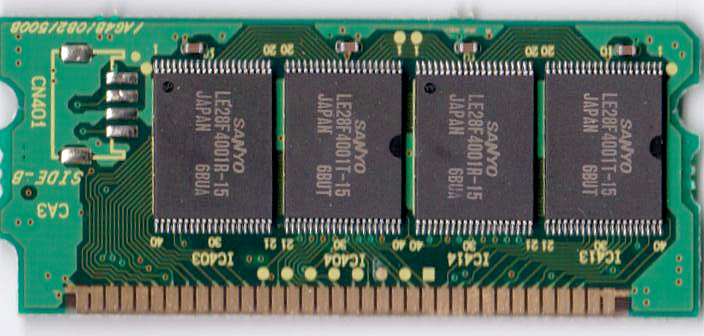
Epson PhotoSpan Memory Module I have almost no information about this one. Apparently Sanyo marketed this expansion module for the Sanyo VPC-G1 camera and it's equivalent models. According to the manual of the original first Epson PhotoPC there were two memory modules available. 2MB and 4MB. Once installed, they could not be removed. This changed with the Epson PhotoPC 500 camera, here it could be put in and taken out but one was strongly advised not to do so. Because the memory modules were ridiculously pricey (up to $399 for the 4MB module) they simply didn't sell.
Introduced by: Probably Sanyo in 1995
Size:roughly 63x23mm
Medium: Flash Memory Module
Voltage:unknown, probably 3 volts
Thickness:approx. 2mm
Pins:36
Used by: Epson PhotoPC, PhotoPC 500, Sanyo VPC-G1 and Sierra Imaging SD640 only
1996 - Serial Flash Module
It's kind of bl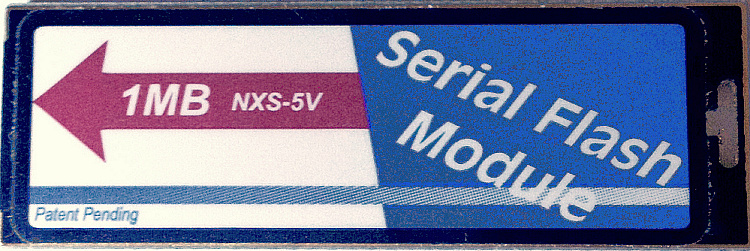 urry but I hope I can shed some light. If I am wrong please let me know. NexCom Technology Inc., a manufacturer of Serial Flash Memory Products, launched this Serial Flash Module in 1996. It used the company's patented low-voltage NexFLASH technology. In late 1997 Integrated Silicon Solution Inc. (ISSI) acquired NexCom. Then in 1998 ISSI spun off it's flash memory business into a new company, NexFlash Technologies Inc., to trim costs.
urry but I hope I can shed some light. If I am wrong please let me know. NexCom Technology Inc., a manufacturer of Serial Flash Memory Products, launched this Serial Flash Module in 1996. It used the company's patented low-voltage NexFLASH technology. In late 1997 Integrated Silicon Solution Inc. (ISSI) acquired NexCom. Then in 1998 ISSI spun off it's flash memory business into a new company, NexFlash Technologies Inc., to trim costs.
 The Serial Flash Module was intended to fill the gap between Smart media Cards and regular Flash Cards. It would fit were no other card would. It was not only aimed at the digital camera market but rather as a multi-purpose memory storage module. In their own words "ideal for microcontroller-based applications, small portable and mobile products, and other resource-limited systems that store data, voice, and images". ISSI is still an active company today but the SFM never took off in the digital camera market. No cardreader existed for these modules but there were plans to market one. I don't think they exceeded 4MB in capacity.
The Serial Flash Module was intended to fill the gap between Smart media Cards and regular Flash Cards. It would fit were no other card would. It was not only aimed at the digital camera market but rather as a multi-purpose memory storage module. In their own words "ideal for microcontroller-based applications, small portable and mobile products, and other resource-limited systems that store data, voice, and images". ISSI is still an active company today but the SFM never took off in the digital camera market. No cardreader existed for these modules but there were plans to market one. I don't think they exceeded 4MB in capacity. Introduced by: NexCom Technology Inc. in 1996
Introduced by: NexCom Technology Inc. in 1996
Size:approx. 45x15mm
Medium: Flash Memory Module
Voltage:3 and 5 Volts
Thickness:varied around 3mm
Pins:8
Used by: Relisys Dimera 2000, 3500 and Trust Photocam, Photocam Plus
1997 - Multimedia Card
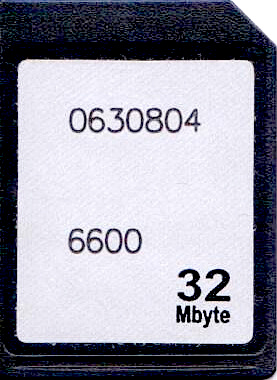
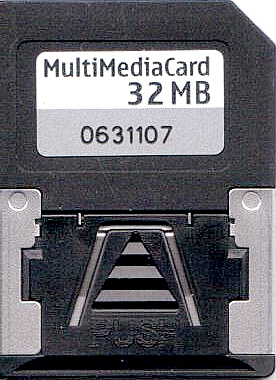 Developed by SanDisk and Igentix (a Siemens subsidiary), the Multimedia Card was unveiled in 1997. It is based on Toshiba flash memory and at that time much smaller than earlier memory cards. The MMC is a typical flash memory card intended for portable devices like digital cameras, PDA's and cellphones. Despite it's small form factor, the MMC didn't find it's way into digital cameras at first but rather in PDA's and cellphones. It wasn't until 2002 when Kodak (among others) implemented MMC cards into their digital cameras. At that time the improved Secure Digital Card had already taken over the SmartMedia Card. In 2004 a reduced-size MMC was released but camera manufacturers weren't too eager to implement single MMC slots in digital cameras. Most cameras were thus equipped with MMC and SD storage possibilities.
Developed by SanDisk and Igentix (a Siemens subsidiary), the Multimedia Card was unveiled in 1997. It is based on Toshiba flash memory and at that time much smaller than earlier memory cards. The MMC is a typical flash memory card intended for portable devices like digital cameras, PDA's and cellphones. Despite it's small form factor, the MMC didn't find it's way into digital cameras at first but rather in PDA's and cellphones. It wasn't until 2002 when Kodak (among others) implemented MMC cards into their digital cameras. At that time the improved Secure Digital Card had already taken over the SmartMedia Card. In 2004 a reduced-size MMC was released but camera manufacturers weren't too eager to implement single MMC slots in digital cameras. Most cameras were thus equipped with MMC and SD storage possibilities.
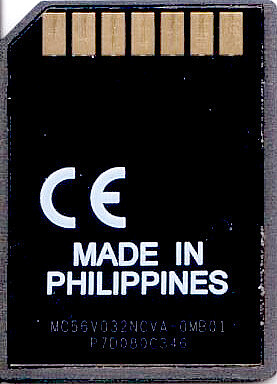 Introduced by: Sandisk in 1997
Introduced by: Sandisk in 1997
Size:approx. 32x24mm (MMC) and 24x18mm (RS-MMC)
Medium: Flash Memory Card
Voltage:3.3V (MMC) and 1.8/3.3V (RS-MMC)
Thickness:1.4mm
Pins:7
Versions:MMC, RS-MMC, MD-MMC, DV-MMC, MMCplus and MMCmobile, MMCmicro a.o.
Used by: No cameras before 2002. After that several Casio Exilims, Kodak CXs, Ricoh Caplios a.o.
1998 - Memory Stick
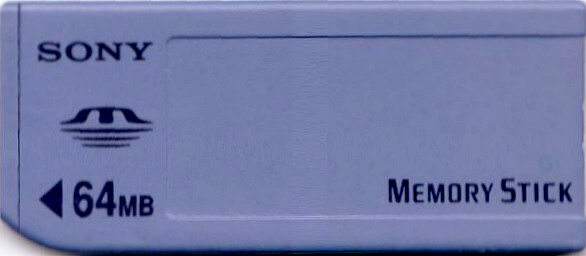
Memory Stick Front 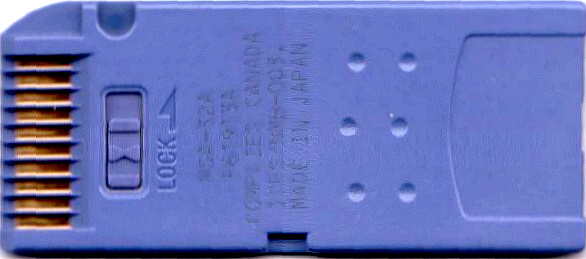
Memory Stick rear In a press release of July 1998, Sony announced to release the Memory Stick (MS) recordable IC memory card. Like no memory card before, the MS promised high-speed data access and a slim design. The MS release was backed up by companies such as Aiwa, Casio, Fujitsu, Sanyo and Sharp. It was designed for use with personal computers and a wide variaty of digital AV products. Sony also promised the MS to be a new standard for data exchange and made plans to develop new consumer electronic products designed for use with the MS. Together with the Compact Flash Card the Memory Stick is the oldest flash memory card still in production today.

Memory Stick Duo front 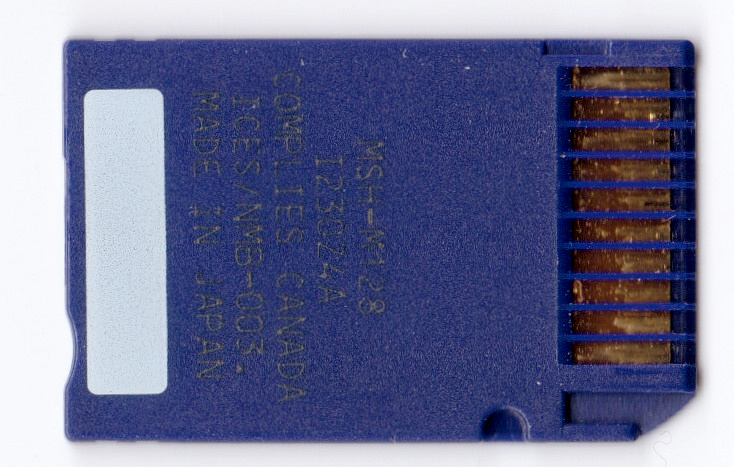
Memory Stick Duo rearCompared to the original Memory Stick, the MS Duo was reduced almost by 50% and made it more compatible with the other small memory cards.
Introduced by: Sony in 1998
Size:approx. 21x50mm
Medium: Flash Memory Card
Voltage:3.3V
Thickness:2.8mm
Pins:10
Versions:MS select, MS PRO, MS Duo, MS Pro Duo, MS Pro-HG Duo, MS Micro M2, MS XC
MS Pro-HG Duo HX, MS Mark 2
Used by: Sony DSC-F55(v), Sony DSC-F505(v) and several MVC-FDxx cameras after 1998
1997/1998 - 120MB Super Disk
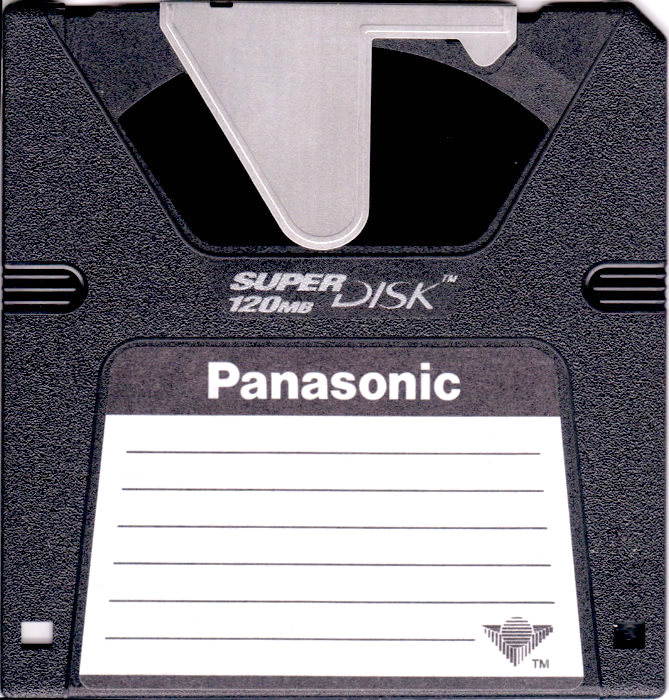
Imation 120MB Super Disk front 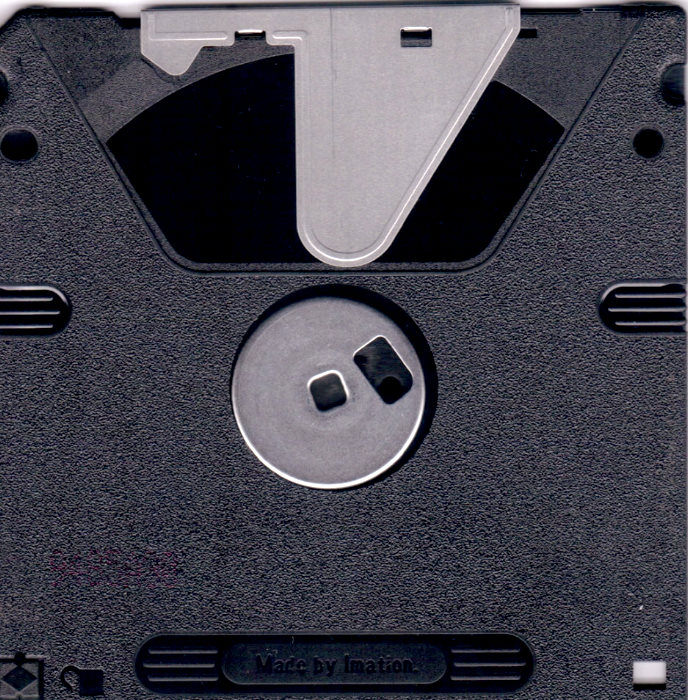
Imation 120MB Super Disk rear Developed in 1997 and marketed in 1998, the Super Disk was meant to supercede Sony's Floppy Disk. 3M's storage products group developed it in 1997. The company spin-off later became Imation. Apart from Panasonic only few OEM companies were interested in the hardware and disks. Only Panasonic used the technology in digital cameras. With Iomega's ZIP already on the market and the CD-R(W) upcoming, the Super Disk technology became obsolete in 2000.
Introduced by: Imation in 1997
Size:approx. 90x94mm
Medium: analog magnetic disk
Versions:120MB and 240MB
Used by: Panasonic PV-SD4090, PV-SD5000 only
1999 - Compact Flash Card Type II
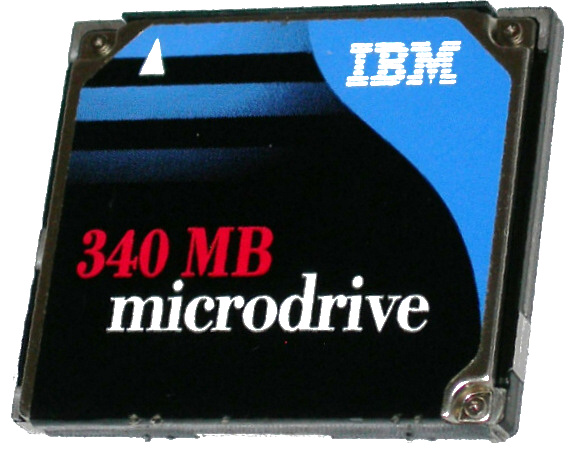
IBM Microdrive  The Compact Flash card Type II is usually a Microdrive and contains a 1-inch miniature hard disk. The Microdrive was introduced to the market in 1999 by IBM. The first ones had a capacity of 170MB and were the smallest hard drives in the world at that time. Until 2003 they only existed as IBM microdrives, then Hitachi bought the hard disk business from IBM and the term "Microdrive" kind of vanished. Only a few companies built them like IBM, Hitachi and Seagate. Sony-labeled versions also existed but they were made by Hitachi and only licensed to Sony. Microdrives were removable CF Typ II cards but integrated versions also existed. For example in early car navigation units and MP3 players. Until 2012 Microdrives were built with capacities of up to 12GB. Today, no company seems to produce them anymore. Interesting enough, Citizen Corporation had built a similar Microdrive back in 1992 for Hewlett-Packard, nicknamed Kittyhawk. For different reasons, like high production costs, it failed to sell and dissappeared from the market in 1994.
The Compact Flash card Type II is usually a Microdrive and contains a 1-inch miniature hard disk. The Microdrive was introduced to the market in 1999 by IBM. The first ones had a capacity of 170MB and were the smallest hard drives in the world at that time. Until 2003 they only existed as IBM microdrives, then Hitachi bought the hard disk business from IBM and the term "Microdrive" kind of vanished. Only a few companies built them like IBM, Hitachi and Seagate. Sony-labeled versions also existed but they were made by Hitachi and only licensed to Sony. Microdrives were removable CF Typ II cards but integrated versions also existed. For example in early car navigation units and MP3 players. Until 2012 Microdrives were built with capacities of up to 12GB. Today, no company seems to produce them anymore. Interesting enough, Citizen Corporation had built a similar Microdrive back in 1992 for Hewlett-Packard, nicknamed Kittyhawk. For different reasons, like high production costs, it failed to sell and dissappeared from the market in 1994.
Introduced by: IBM in 1999
Size:approx. 43x36mm
Medium: Magnetic storage device
Voltage:3.3/5 Volts
Thickness:5mm
Pins:50
Used by: Canon PowerShot Pro 70 and 90, Minolta Dimage RD-3000, Pentax EI-200, Nikon D1
Canon EOS D30 and some Sanyo VPC-SX models from 1999 a.o.
1999 - Clik!
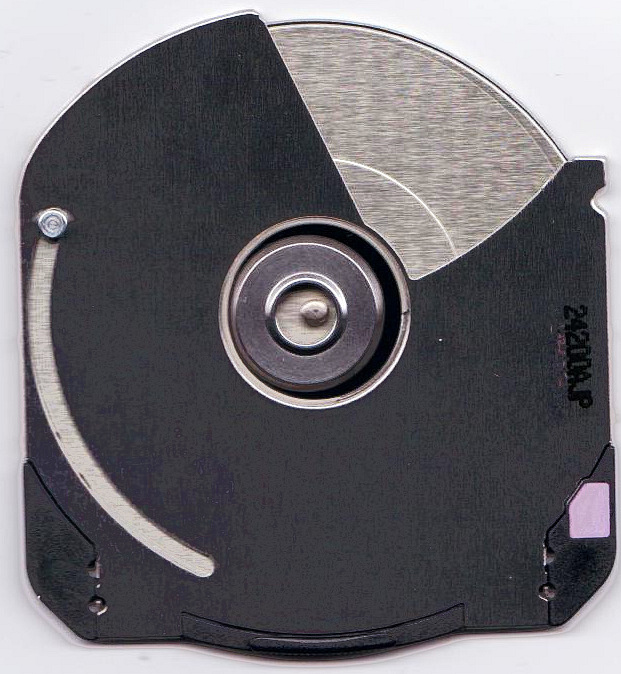 Iomega introduced the Clik! disk in 1999. Intended as a backup and portable storage solution in Clik! drives. Originally it was a PC card slot drive and should compete with PC card, Smart Media and Compact Flash readers. Later USB versions and Desktop Computer solutions were offered. After the "click of death" lawsuit involving Iomega's ZipDrives, the Clik! drive was renamed PocketZip. The discs only had a capacity of 40MB and the drives were only integrated in a few portable devices. Although Iomega announced a 100MB disc but before it was marketed it became vaporware and the drive itself was discontinued shortly after.
Iomega introduced the Clik! disk in 1999. Intended as a backup and portable storage solution in Clik! drives. Originally it was a PC card slot drive and should compete with PC card, Smart Media and Compact Flash readers. Later USB versions and Desktop Computer solutions were offered. After the "click of death" lawsuit involving Iomega's ZipDrives, the Clik! drive was renamed PocketZip. The discs only had a capacity of 40MB and the drives were only integrated in a few portable devices. Although Iomega announced a 100MB disc but before it was marketed it became vaporware and the drive itself was discontinued shortly after.

PocketZIP disc Introduced by: Iomega in 1999
Size:approx. 43x36mm
Medium: Magneto-optical device
Thickness:5mm
Versions:40MB Clik! disc and PocketZIP
Used by: Agfa ePhoto CL30 Clik! only
2000 - Sanyo ID Photo Disk
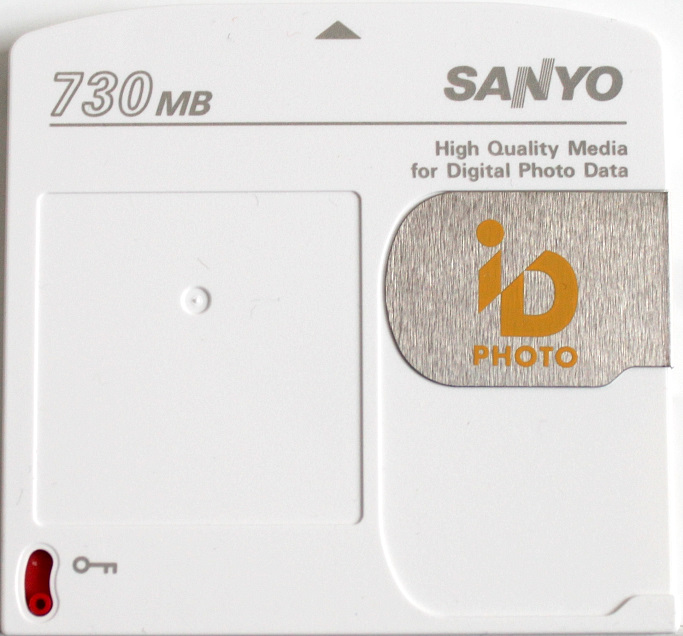
Sanyo ID Photo Disk 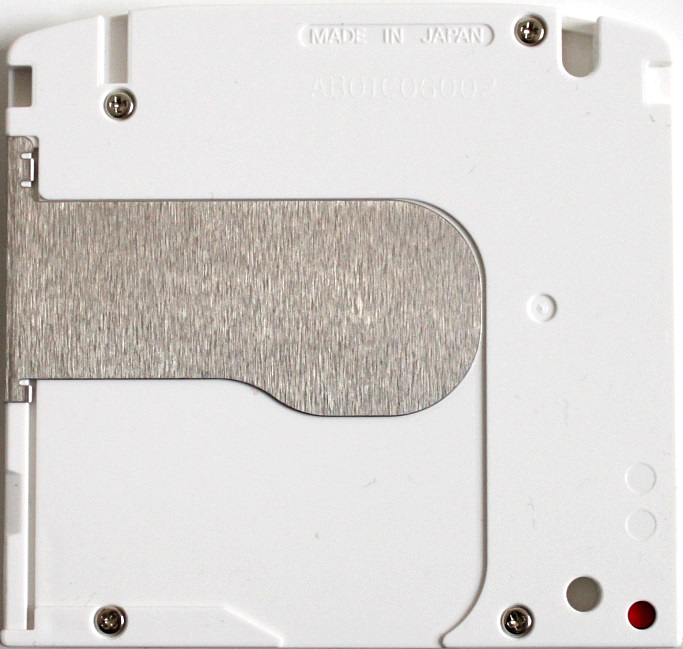 Sanyo teamed up with Olympus and Hitachi-Maxell and developed a different kind of storage disk. Well, basically a smaller version of the AS-MO (Advanced Storage-Magneto Optical) disk. This new disk, dubbed the Photo ID, was different though. It allowed for 730MB of storage and it's rather fast write/read speed (10 to 50 Mbps) was also pretty impressive back then. Other impressive figures were that data could be overwritten one million times and the disk ought to have a life expectancy of 100 years without losing data! This was the highest life expectancy for any recording medium so far.
Sanyo teamed up with Olympus and Hitachi-Maxell and developed a different kind of storage disk. Well, basically a smaller version of the AS-MO (Advanced Storage-Magneto Optical) disk. This new disk, dubbed the Photo ID, was different though. It allowed for 730MB of storage and it's rather fast write/read speed (10 to 50 Mbps) was also pretty impressive back then. Other impressive figures were that data could be overwritten one million times and the disk ought to have a life expectancy of 100 years without losing data! This was the highest life expectancy for any recording medium so far.
Sanyo showcased a prototype at the CeBIT 2000 dubbed the SX-111. Later that same year they presented the IDC-1000Z ID Photo Disk Camera at the Photokina. Other companies like Ricoh, Nikon, Minolta and Olympus showed interest in this promising technology and Olympus even planned to market a camera too. But things turned out... well, the way they turned out and the IDC-1000Z sold poorly. Despite all efforts, the sales figures of the ID Photo Disk and the IDC-1000Z led to the demise of this recording medium and the, now sought after, Sanyo IDC-1000Z remained the only camera to sport this storage medium.
Introduced by: Sanyo Fisher in 2000
Size:approx. 59x56mm
Medium: magnetic disk
Versions:730MB only
Used by: Sanyo IDC-1000Z only
2000 - Secure Digital SD Card

 In 1999 SanDisk, Matsushita and Toshiba agreed to developed the Secure Digital card, a development of the above mentioned Multi Media Card. The card was supposed to feature Digital Rights Managment and a higher memory density. It was to compete with Sony's Memory Stick. Funny enough the SD logo was once designed for Toshiba's Super Density Disc which lost the DVD format war. They kept the logo and used it for the SD card. The card itself was introduced in 2000 at the CES fair and production started a few months later. The SD card gained fast popularity and is the most common slot interface in digital cameras today.
In 1999 SanDisk, Matsushita and Toshiba agreed to developed the Secure Digital card, a development of the above mentioned Multi Media Card. The card was supposed to feature Digital Rights Managment and a higher memory density. It was to compete with Sony's Memory Stick. Funny enough the SD logo was once designed for Toshiba's Super Density Disc which lost the DVD format war. They kept the logo and used it for the SD card. The card itself was introduced in 2000 at the CES fair and production started a few months later. The SD card gained fast popularity and is the most common slot interface in digital cameras today.


In 2001 SmartMedia was used in 50% of all digital cameras, by 2005 the SD card had reached 40% of the digital camera market. Due to it's popularity fake SD cards keep appearing on the market, especially the faster cards with higher capacity are subject to counterfeiting.
 Introduced by: SanDisk, Matsushita und Toshiba in 2000
Introduced by: SanDisk, Matsushita und Toshiba in 2000
Size:approx. 32x24mm
Medium: Flash Memory Card
Voltage:3.3V (SD) and 1.8/3.3V (SDxC)
Thickness:2.1mm
Pins:9 (SD), 11 (miniSD) and 8 (microSD)
Versions:SD, SDHC, SDXC, miniSD, microSD, Eye-Fi and the rare Thin SD
Used by: among the first were: Panasonic PV-DC3000, Minolta Dimage X20, Trust 750 LCD, Concord Eye-Q 2000 and a lot more
2001 - DataPlay Disc

DataPlay Disc DataPlay Inc. from Boulder, Colorado unveiled this optical digital disc at the CES 2001 in Las Vegas. The disc itself was made by Imation. It could be read like a CD with a data transfer rate of 1MB/s. Although you could read it many times, the disc could only be written to once. After data was stored on it, it's contents was encrypted. Although intended for music, Toshiba showed interested and demonstrated a digital camera prototype for the disc at the CES 2001 and CeBIT 2001, based on the PDR-M70 model.
DataPlay Inc. also showed a possible digital camera prototype to support the storage medium. Both prototypes can be seen in the prototypes & rarities section. The industry was generally supportive of the medium but not to keen on supporting it. Very few players had been marketed and only a handful of pre-recorded DataPlay Discs. Only a year after demonstrating the disc, DataPlay Inc. filed for bankruptcy. The entire DataPlay product chain became instant vaporware and are now collectible items due to the very limited production numbers.
| Introduced by: |
DataPlay Inc. in 2001 |
|
| Size: | 39 x 33 x 3mm | |
| Medium: | optical disk | |
| Versions: | 250 and 500MB |
|
| Used by: | Toshiba PDR-M70 clone prototype and DataPlay digital camera prototype |
2002 - xD-Picture Card
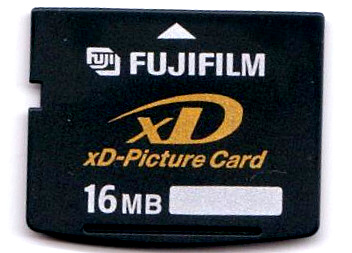
xD-Picture Card  Developed by Olympus and Fujifilm, the xD-Picture card is actually manufactured by Toshiba and Samsung. It was to compete with Compact Flash and Secure Digital cards as well as Sony's Memory Stick. Introduced in July 2002 the cards became proprietary to Fujifilm and Olympus and therefore couldn't stand the test of time. It derived directly from the SmartMedia card and couldn't keep up with the fast progress in transfer rates and speed of other cards. Besides the xD-Picture card was always more expensive than other flash cards. Apparently the xD-Picture is still manufactured today but digital cameras supporting them exclusively are not. xD-Picture cards were also sold under other brand names like Kodak, PNY, Lexar and even SanDisk but do not bear their logos except those sold by Kodak.
Developed by Olympus and Fujifilm, the xD-Picture card is actually manufactured by Toshiba and Samsung. It was to compete with Compact Flash and Secure Digital cards as well as Sony's Memory Stick. Introduced in July 2002 the cards became proprietary to Fujifilm and Olympus and therefore couldn't stand the test of time. It derived directly from the SmartMedia card and couldn't keep up with the fast progress in transfer rates and speed of other cards. Besides the xD-Picture card was always more expensive than other flash cards. Apparently the xD-Picture is still manufactured today but digital cameras supporting them exclusively are not. xD-Picture cards were also sold under other brand names like Kodak, PNY, Lexar and even SanDisk but do not bear their logos except those sold by Kodak.
Introduced by: Olympus and Fujifilm in 2002
Size:approx. 25x20mm
Medium: Flash Memory Card
Voltage:3,3 Volts
Thickness:1.78mm
Pins:18
Used by: Limited to older Olympus and Fujifilm digital cameras



